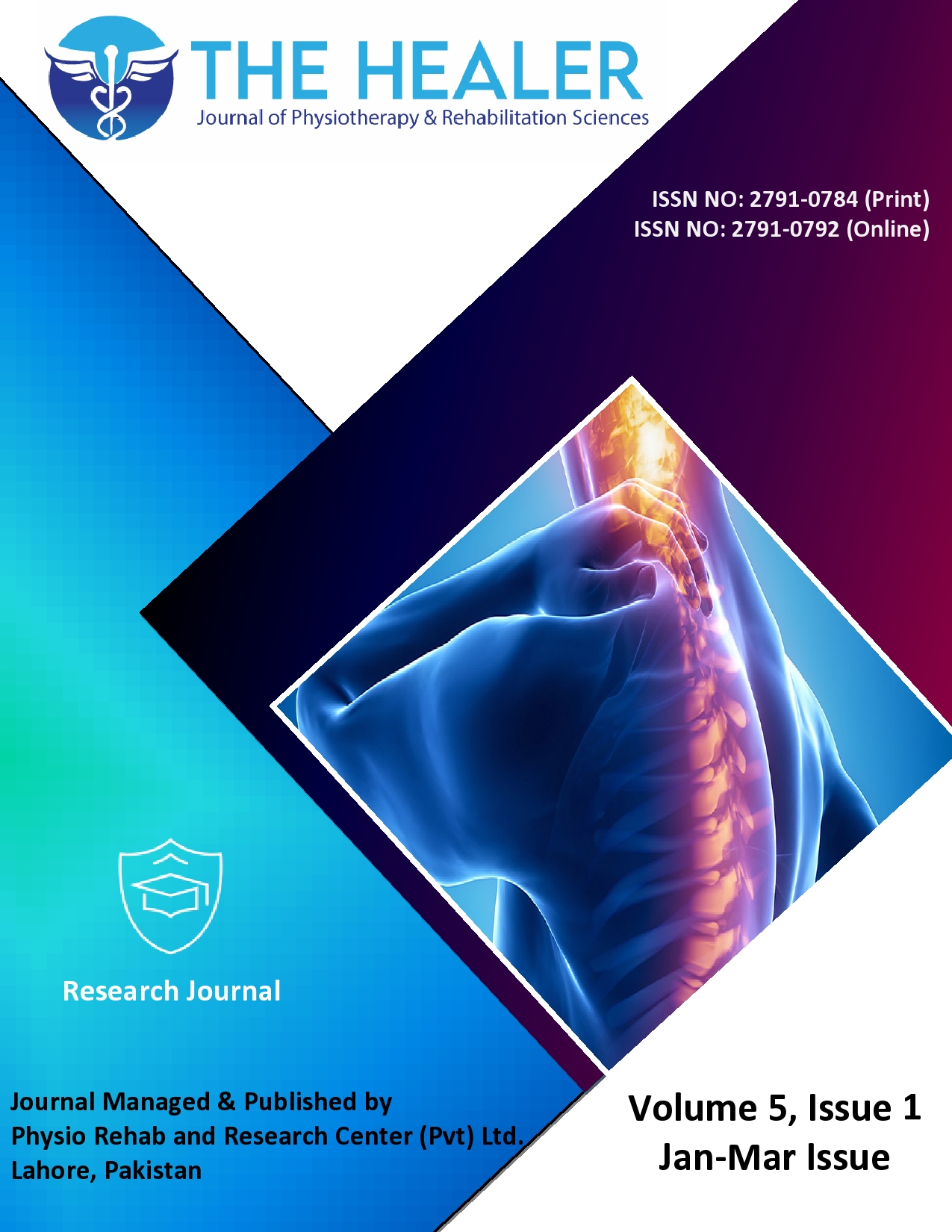Effects of Maitland and Mulligan’s Mobilization Technique in Treatment of Post-CABG Adhesive Capsulitis
DOI:
https://doi.org/10.55735/42hjwc20Keywords:
Adhesive capsulitis , Maitland mobilisation , Mulligan mobilisation , Post-CABGAbstract
Background: Adhesive capsulitis is a condition characterized by pain and restriction of the shoulder range of motion. This may be predisposed by cardiac surgery, as patients need to immobilize their upper limbs after surgery. Objective: Effects of Maitland and Mulligan’s mobilization techniques in the treatment of post-CABG adhesive capsulitis. Methodology: In this randomized clinical trial, participants were recruited using convenience sampling, with a total of 48 individuals enrolled. Random allocation into two groups was carried out through a simple lottery method, assigning patients with post-CABG adhesive capsulitis from Faisalabad Institute of Cardiology to two groups. Males and females between 40 and 60 years of age presented with shoulder pain, restricted range of motion, and limited movements in abduction and external rotation were included, and those with neurological conditions, traumatic injuries, osteoarthritis, or bony abnormalities, history of surgery, or musculoskeletal disorders were excluded. Screening procedures included baseline evaluation using the numeric pain rating scale and shoulder pain and disability index scores to assess pain and shoulder disability, respectively. The therapist applied the Mulligan technique to Group A with three sets of 10 repetitions, with 30 sec' rest between sets, and the Maitland technique to Group B at the rate of 2-3 glides per second for 30 seconds, and each glide was given for 5 sets to meet the requirement of this treatment. Within-group analysis was done using a paired sample t-test. Between-group analysis was done using the Mann-Whitney U and independent t-tests. Results: Both of the treatment groups showed significant improvement in frozen shoulder patients with a p-value of numeric pain rating scale and shoulder pain and disability index, p=0.00, which is less than 0.05 (p<0.05). The comparison between both groups showed that the Mulligan mobilization showed more improvements than the Maitland mobilization, with a p-value (p<0.05). Conclusion: This indicates a significant improvement in treatment outcomes with both Mulligan and Maitland mobilization techniques for managing pain and disability in post-CABG adhesive capsulitis. However, the Mulligan mobilization demonstrates comparatively greater effectiveness than the Maitland mobilization.
Downloads
References
1. Chokkalingam M, Saradha S, Navitha A, Nayar PG. Incidence and clinical profile of patients with frozen shoulder after cardiac surgery. Journal of Clinical and Preventive Cardiology 2017; 6(4): 142–6.
https://doi.org/10.4103/JCPC.JCPC_17_17 DOI: https://doi.org/10.4103/JCPC.JCPC_17_17
2. Le HV, Lee SJ, Nazarian A, Rodriguez EK. Adhesive capsulitis of the shoulder: review of pathophysiology and current clinical treatments. Shoulder and Elbow 2017; 9(2): 75–84. https://doi.org/10.1177/1758573216676786 DOI: https://doi.org/10.1177/1758573216676786
3. Manske RC, Prohaska D. Diagnosis and management of adhesive capsulitis. Current Reviews in Musculoskeletal Medicine 2008; 1(3): 180–9.
https://doi.org/10.1007/s12178-008-9031-6 DOI: https://doi.org/10.1007/s12178-008-9031-6
4. Lewis J. Frozen shoulder contracture syndrome–Aetiology, diagnosis and management. Manual Therapy 2015; 20(1): 2–9.
https://doi.org/10.1016/j.math.2014.07.006 DOI: https://doi.org/10.1016/j.math.2014.07.006
5. Jacobson JA. Shoulder US: anatomy, technique, and scanning pitfalls. Radiology 2011; 260(1): 6–16.
https://doi.org/10.1148/radiol.11101082 DOI: https://doi.org/10.1148/radiol.11101082
6. Vermeulen HM, Rozing PM, Obermann WR, Le Cessie S, Vliet Vlieland TP. Comparison of high-grade and low-grade mobilization techniques in the management of adhesive capsulitis of the shoulder: randomized controlled trial. Physical Therapy 2006; 86(3): 355–68.
https://doi.org/10.1093/ptj/86.3.355 DOI: https://doi.org/10.1093/ptj/86.3.355
7. Agarwal S, Raza S, Moiz JA, Anwer S, Alghadir AH. Effects of two different mobilization techniques on pain, range of motion and functional disability in patients with adhesive capsulitis: a comparative study. Journal of Physical Therapy Science 2016; 28(12): 3342–9.
https://doi.org/10.1589/jpts.28.3342 DOI: https://doi.org/10.1589/jpts.28.3342
8. Hanchard NC, Goodchild L, Thompson J, O’brien T, Davison D, Richardson C. Evidence-based clinical guidelines for the diagnosis, assessment and physiotherapy management of contracted (frozen) shoulder: quick reference summary. Physiotherapy 2012; 98(2): 117–20.
https://doi.org/10.1016/j.physio.2012.01.001 DOI: https://doi.org/10.1016/j.physio.2012.01.001
9. Nicholson GG. The effects of passive joint mobilization on pain and hypomobility associated with adhesive capsulitis of the shoulder. Journal of Orthopaedic & Sports Physical Therapy 1985; 6(4): 238–46.
https://doi.org/10.2519/jospt.1985.6.4.238 DOI: https://doi.org/10.2519/jospt.1985.6.4.238
10. Ali M, Hashim M, Waseem I, et al. Comparison of Maitland Mobilization and Muscle Energy Technique on Pain, Range of Motion and Functions in Adhesive Capsulitis: Comparison of Maitland Mobilization and Muscle Energy Technique. Pakistan BioMedical Journal 2022; 5(1): 129–133. https://doi.org/10.54393/pbmj.v5i1.188 DOI: https://doi.org/10.54393/pbmj.v5i1.188
11. Kumar A, Kumar S, Aggarwal A, Kumar R, Das PG. Effectiveness of Maitland Techniques in idiopathic shoulder adhesive capsulitis. International Scholarly Research Notices 2012; 2012(1): 710235.
https://doi.org/10.5402/2012/710235 DOI: https://doi.org/10.5402/2012/710235
12. Yeole UL, Dighe PD, Gharote GM, Panse RS, Shweta A, Pawar PA. Effectiveness of movement with mobilization in adhesive capsulitis of shoulder: Randomized controlled trial. Indian Journal of Medical Research and Pharmaceutical Sciences 2017; 4(2): 1–8.
https://doi.org/10.5281/zenodo.266638
13. Awan WA, Aftab A, Kafeel S, Kanwal R, Ahmed A, Qureshi M. Prevalence and associated risk factors of adhesive capsulitis in post cardiac surgery patients. Pakistan Heart Journal 2019; 52(3).
https://doi.org/10.47144/phj.v52i3.1790
14. Kingston K, Curry EJ, Galvin JW, Li X. Shoulder adhesive capsulitis: epidemiology and predictors of surgery. Journal of Shoulder and Elbow Surgery 2018; 27(8): 1437–43.
https://doi.org/10.1016/j.jse.2018.04.004 DOI: https://doi.org/10.1016/j.jse.2018.04.004
15. Noten S, Meeus M, Stassijns G, et al. Efficacy of Different Types of Mobilization Techniques in Patients With Primary Adhesive Capsulitis of the Shoulder: A Systematic Review. Archives of Physical Medicine and Rehabilitation 2016; 97(5): 815–825.
https://doi.org/10.1016/j.apmr.2015.07.025 DOI: https://doi.org/10.1016/j.apmr.2015.07.025
16. Rizwan M, Razzaq A, Ijaz S, Amin T. Comparing the effect of Kaltenborn and Maitland mobilization on pain and disability in adhesive capsulitis. International Journal of Advanced Research and Publications 2019; 3(5): 176-179. 17. Patel B, Bid D. Effectiveness of muscle energy technique and movement with mobilization in adhesive capsulitis of shoulder. International Journal of Applied Research 2022; 8(3): 395-403.
https://doi.org/10.22271/allresearch.2022.v8.i3e.9594 DOI: https://doi.org/10.22271/allresearch.2022.v8.i3e.9594

Downloads
Published
License
Copyright (c) 2025 The Healer Journal of Physiotherapy and Rehabilitation Sciences

This work is licensed under a Creative Commons Attribution 4.0 International License.














